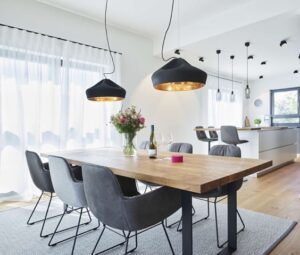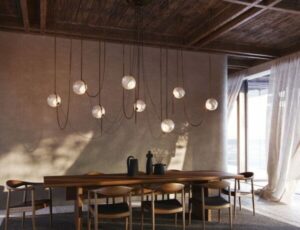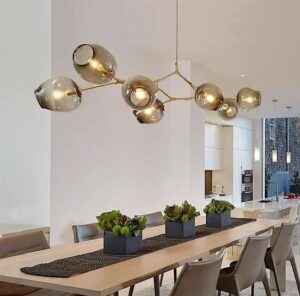For generations, the pendant or chandelier has ruled the dining room with quiet authority. It sat proudly above the table—perfectly centred, perfectly aligned—a symbol of order and tradition. We made sure that the fixture and table were in flawless symmetry, as if balance itself could guarantee good taste. But design, much like life, evolves. The dining room has transformed from a formal, seldom-used space to one of the busiest corners of modern homes, often merging with the kitchen to create larger, open-plan living areas. Now, it’s a homework zone in the afternoon, a casual café in the morning, and the backdrop for intimate dinners at night. That single, centred pendant or chandelier—once the grand statement of elegance—no longer carries the whole performance. It’s time to rethink how we light this most important room in the home.
From Precision to Personality
The idea of absolute precision has given way to personality. Perfect symmetry may still have its place in classic interiors, but today’s dining spaces often crave something more expressive—lighting that complements how the room is truly lived in. Rather than fixating on the midpoint of the ceiling, designers now see light as a tool to shape atmosphere and highlight activity. For example, a slightly off-centre pendant or chandelier that hugs the ceiling can add intrigue, or a cluster of smaller pendants can create rhythm and movement. These subtle imbalances make a room feel more natural, as if it has evolved over time rather than being staged for a photograph. When lighting reflects life, it feels authentic. A family gathered for dinner doesn’t sit in geometric precision—conversations flow, laughter bounces, chairs shift—and the lighting should embrace that same organic energy.

Flexibility Is the Key
Lighting plays a vital role in how we experience a dining space, and flexibility is often the secret to achieving the perfect mood. Sometimes, extra brightness is needed—such as when reading or working at the dining table—but during meals, a softer, more intimate glow is preferred. This is where a pendant light with a pulley system truly shines. Unlike a fixed pendant, a pulley system allows you to easily adjust the height of the light, bringing it closer for focused tasks or raising it to create a relaxed, ambient atmosphere. While dimmable lights offer some control, a pulley adds a tactile, visual element that feels both functional and stylish. The movement itself becomes part of the design, adding a subtle “wow” factor that elevates the room’s aesthetic.
A pendant with a pulley system offers a balance of sophistication and modern practicality. It transforms a simple dining area into a versatile, dynamic space—one that adapts effortlessly to every occasion, from a quiet meal to a lively gathering or even a moment of reading under the warm, adjustable glow. Contact us here if you need assistance with this type of lighting.

Multiple Is Magnificent
There’s something captivating about the balance and symmetry of a multi-arm chandelier or a clustered multi-light pendant arrangement. These designs bring an immediate sense of grandeur to the dining room, filling the space with light and visual rhythm. Rather than positioning fixtures directly over the dining table, these lights can be beautifully integrated into the architecture of the room itself, provided it is done properly. One elegant approach is to suspend a multi-arm chandelier or mulit-light pendant within a recessed ceiling space. This technique connects the lighting to the architectural lines of the ceiling rather than the placement of furniture below. The result is a cohesive, built-in look that feels intentional and refined—a true design statement rather than just a source of light. If your dining space doesn’t include a recessed ceiling, a recessed adjustable downlight or spotlight can achieve a similar effect. Most often, a chandelier or pendant comes with an adjustable cord or cable to allow for an on-site adjustment. Acting as a visual anchor, this detail frames the chandelier or pendant, drawing the eye upward and creating a sense of proportion and elegance. By embracing the beauty of multiple light sources and thoughtful ceiling details, you can transform the dining room into a well-balanced composition—one where light, form, and architecture come together in harmony.
Dining as an Experience
Lighting does more than make a room visible—it shapes emotion. The right illumination can make food look richer, faces warmer, and moments more memorable. A dining room should invite people to linger and talk a little longer after the plates are cleared. This is where lighting design becomes storytelling. A soft halo of light over the tabletop draws focus to conversation. A gentle glow on the ceiling opens up the space, while side lighting adds depth and intimacy. Together, they create the mood for an evening you never want to end.

The Heart of the Home
In many ways, the dining room is the true heart of the home. It’s where celebrations unfold, birthdays are sung, and quiet nights turn into cherished memories. The pendant or chandelier—whether grand and sculptural or simple and understated—acts as the symbol of gathering. But the rulebook that once dictated where it must hang or how it must look no longer applies. The modern dining room celebrates flexibility and personality. Lighting isn’t just a finishing touch; it’s woven into the very architecture of how we live, dine, and connect. So perhaps perfection isn’t the goal anymore. Maybe what we need above the table isn’t a rigid statement of balance, but a touch of artistry—light that adapts, surprises, and makes every meal feel like an occasion.
